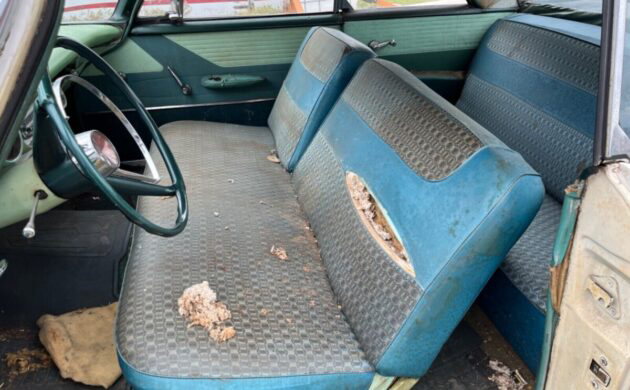The Windsor debuted in 1939 and would remain in the Chrysler U.S portfolio through 1961. Typically, it was the entry-level model that led the way to the more luxurious New Yorker (and the Imperial, which didn’t always carry a Chrysler badge). As part of the “Forward Look” automobiles of the late 1950s, this ’57 Windsor yearns for a restoration, which will include sheet metal work due to rust. Located in Mount Jackson, Virginia, this old Mopar is available here on eBay where the first bid of $3,800 has yet to be cast. Another great tip from barn finder Larry D!
Chrysler pulled out all the stops when they redesigned their cars in 1957, including Plymouth, Dodge, and DeSoto. They caught the competition off guard as these automobiles looked more futuristic than what GM and Ford had to offer. Perhaps the most noticeable were the huge, sweeping rear fender fins. But the cars were also new below the sheet metal, with torsion bar suspension being the big innovation that year. After the 1957 Chryslers went into production, dual headlamps were approved by the Feds and began to appear on later entries in the season.
This ’57 Windsor was likely in storage for a while as it doesn’t run and has more than its fair share of rust, not uncommon with these Forward Look Chryslers. This is not the first-time rust was an issue as older bodywork can be found in places, such as the rocker panels, the eyebrows on the fenders, the trunk, and especially the rear quarter panels. The interior will also require some attention, although the rear seat is in better shape than the front.
Under the hoods resides a 354 cubic inch OHV V8 with “Polyspherical” combustion chambers. With a moderate compression ratio, these engines were rated at 285 hp, and fuel was delivered via a 2-barrel Carter carburetor. Buyers who opted for an automatic transmission were treated to a pushbutton set-up to the left of the steering wheel. Chrysler production totaled 122,000 automobiles in 1957, with the lower-level Windsor 2-door hardtop like this one coming in at 14,000 units. This car is going to need a lot of work which equates to time and money but what an awesome sight it would make brought back to its original glory.






The wire wheels are worth $4000 all by themselves. I’m not up on parts prices like I used to be, but they were always a welcome find when searching through the attics of old dealerships.
Let me know if you want to invest in a set of these wheels – at that price I would gladly give up my set I’m holding for my Fury.
It’s a pile of scrap metal and worth about $200 at best. This is the perfect example of a fool and his money soon part company. Shame on Barn Find for even allowing junk like this to be listed.
Totally disagree there Robert, this is the only thumbnail in today’s BarnFinds email that I even clicked on to see the writeup on.
We RARELY see the Forward-look Windsors get much love since yeah, their MoPar manufacturers decided to use corrosion prone steel alloys in the bodies so not many are left.
But they’re just as kewl as the other 57 MoPars to me and this one sooo obscure to boot…
Nice work finding this one for a writeup BarnFinds, thanks!!!
Even if this car was burned beyond all hope the scrap weight would be more than $ 200 , that alone shows how much you know about cars .
Robert, the car sold for $3,800.00. Having owned hundreds of 1955-68 Chryslers and Imperials of all types, I can attest to the selling price being very fair.
Wow, what an a$$ you are Robert, if it was a pile of rust Chevy you would be all over it like a dog in heat. Go troll somewhere else.
Agree Gary and David…..besides that’s about a two ton car fer sure……
I find it interesting that the power brake unit in this car is a Bendix Hydrovac. The normal power brake unit on a 1957 Chrysler product is an oval exposed rubber bellows, sort of looks like an Accordion, and it sat above the master cylinder, attached to the steel bracket that also holds the m/c in place.
My research suggests ALL 1957 Chryslers were equipped with power brakes as standard equipment, and my MoPaR parts catalog only shows the oval bellows type used 1957-63.
Anyone else got an idea why this has a Hydrovac Power brake unit?